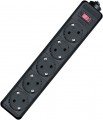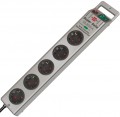Cable length
The length of the cable used to connect the surge protector to the network.
The longer the cable, the farther from the outlet you can install the device. On the other hand, a long cable can be inconvenient over short distances. Models on a coil are deprived of this drawback (see "Type"), this moment is compensated by the actual presence of the coil, but they differ in large dimensions and heavy weight. So when choosing, it is far from always worth chasing the maximum length of the wire.
Max. power
The highest power consumption of the connected devices that the surge protector can tolerate without consequences (to be more precise, with which it can work indefinitely without overloads, overheating, etc.).
This limitation is due to the fact that the higher the power at the same voltage, the higher the current passing through the equipment (in this case, through the surge protector); and off-design currents can lead to breakdowns and even accidents. And although in order to avoid these consequences, modern filters often provide various types of protection (see above), however, the operation of protection is still an emergency situation that is best avoided. Therefore, it is worth choosing a model according to this parameter in such a way that the maximum filter power is at least not lower than the total power consumption of the load. And it is best to have a margin of 20 – 30% — this will give additional guarantees in case of various deviations in the operation of the connected equipment.
Separately, it is worth highlighting the situations when the filter is planned to be used for the so-called reactive load — electrical appliances that widely use circuits on capacitors and/or inductors, for example, power tools or refrigeration units. The total power consumption of such devices (written in volt-amperes) can be much higher than the active power (which is indicated in watts). The recommended line filter power in such cases is calculated using special...formulas that can be found in the relevant sources.
Max. load
The maximum current that the surge protector can pass through itself for an unlimited time without the risk of overheating, breakdowns and other troubles.
This parameter is directly related to the maximum power of the filter (see above): power is the current multiplied by the voltage. Thus, for example, for a standard 230 V model with a maximum power of 2200 W, the maximum load will be 10 A. Note that the characteristics of modern filters may not correspond to such calculations — for example, the same 10 A can be claimed for a 2500 W model . However, this is not something extraordinary: the difference in figures may be due to active and reactive power (see "Maximum power"), the characteristics of single-phase filters (without 400 V sockets, see above) can be given both for 230 V, so for 230 V and even 240 V, figures may be rounded for readability, etc.
Anyway, the practical value of the maximum load is the same as the maximum power: it should not be less than the current supplied to the connected electrical appliances (otherwise the protection may trip, or even break). And they use this parameter, along with the maximum power, because in some cases it is easier to evaluate the characteristics of the load (and filter requirements) in terms of current consumption, and not in terms of power.
Max. energy absorption
The maximum energy absorption provided by the mains filter, namely, the maximum pulse energy at which the device can safely absorb and dissipate it, completely protecting the connected load. The higher this indicator, the more reliable the filter, the more powerful power surges it can handle. In inexpensive models, the maximum absorption is calculated in tens of joules, in the most advanced models it can exceed 1000 J and even 2000 J.
Wire section
The cross-sectional area of the wire used to connect the filter to the network. The larger the cross-sectional area, the thicker the wire, the more reliable it is and the more current it can pass without overheating. Accordingly, thick wires (
1.5 mm² and
2.5 mm²) are a must for high power devices. At the same time, modern manufacturers, usually, choose the cross-sectional area in such a way as to guarantee the safe operation of the filter at the claimed maximum power (see above). Therefore, in fact, a model with a thicker cable than other similar devices should be chosen if it is supposed to be used in unstable networks in which power surges often occur. If the cross-sectional area seems too small for you (
0.75 mm² or
1 mm²) for the claimed power, there are special formulas that allow you to check the validity of such doubts.
Protection
—
Short circuit protection. Short circuit (short circuit) protection system — situations when the impedance in the circuit drops sharply, for example, due to a metal object falling between the socket contacts. It reacts to a sharp increase in current and opens the circuit, allowing you to avoid damage and fire equipment.
—
Voltage drops protection. Protection against power surges in the network. A filter with this function is able to completely cut off power that exceeds the allowable rate set by the manufacturer, protecting the load from damage. Note that the surge protector is not able to replace a full-fledged stabilizer or voltage relay; however, in more or less high-quality networks that are not subject to strong fluctuations, a filter is quite enough.
—
Overload protection. In this case, overload means a situation when the load power exceeds the values \u200b\u200ballowed for a given network filter. This situation is similar to the short circuit described above — high currents go through the filter; however, overload has its own specifics, so protection against it can be provided as a separate system. However, the principle of operation of such systems is classic: when the permissible power is exceeded, it turns off the power, preventing breakdowns and fires.
—
Varistor protection. A kind of protectio
...n against short-term power surges in the network, built on varistors — variable impedance resistors. The impedance of such a resistor under normal conditions is in the millions of ohms, but it drops sharply if the input voltage increases above a certain value. Due to this, in normal mode, the protection practically does not affect the circuit, and with a high-voltage pulse, excess energy “merges” through the varistor and dissipates in the form of heat. The ability of varistors to absorb energy is not infinite, therefore, to protect against overheating, the design usually provides for a temperature sensor with an automatic switch.Safety socket cover
The presence
of protective shutters from children in the design of the surge protector.
Such curtains are shutters that cover the current-carrying parts of the outlet and restrict access to foreign objects (most often, curious children try to put such objects into the outlet — hence the name). The design of the dampers is most often such that they open only under the pressure of the plug, when two contacts press on the curtains at the same time.
Protection level
The degree of protection of electrical appliances is regulated by the international standard IP (International / Ingress Protection Rating). For power strip outlets, the most commonly used protection standards are IP20 and IP44.
Only ordinary household models do not have protection. Devices in the IP20 category have basic protection against dust, but they are not protected against moisture. Sockets rated IP44 and above are capable of withstanding both dust and moisture. Models of this class can be safely used in bathrooms and other rooms with a high level of humidity.

